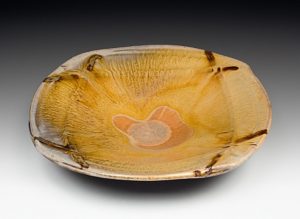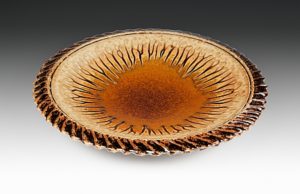 Richard Aerni By E. M. Kinsman
Richard Aerni By E. M. Kinsman
Through the use of local materials and single-fire techniques, New York potter Richard Aerni has developed a singular style incorporating slip trailing under ash glazes. Aerni started handling clay in 1974, but worked in both an organic restaurant and the post office before making the transition to full-time studio potter in 1979.
Teaming with Michael Frasca and Allan Nairn in Cincinnati, he helped create architectural murals and decorative vessels under the name Spring Street Pottery. This partnership was a good training ground for a solo future. Working on large architectural murals, one consuming ten months of the team’s skills, was a particular challenge. The sheer size of the mural and the amount of clay involved forced them to develop highly efficient production techniques.
The murals also gave the team a considerable amount of exposure. “One day this professional designer called asking about our large planters. After inquiring about the price, he ordered 300,” Aerni recalled. The only problem was they had to be delivered in 10 weeks. There was barely enough time to throw the pots, leaving little room in the schedule for bisque and glaze firings. But the order was filled on time by single firing.
Seven years ago, when Aerni’s wife, April, accepted a teaching position at a college in Rochester, the couple moved to New York State. A farm home in Bloomfield offered the best compromise of studio space and proximity to Rochester. Bloomfield is a small farming community, scenically located between New York’s Finger Lakes and the city of Rochester, some 30 miles away.
It is ju st a few steps from the kitchen table to the heart of Aerni’s studio. Besides several potter’s wheels, worktables and related clay equipment, the studio houses a variety of woodworking tools and equipment that are used to restore the farmhouse. Shelves along the walls are used for drying pots as well as storing materials. Windows face both the east and south for natural light. The southern windows overlook a small grove of fruit trees and a pond. Two cats, one of which is a good mouser, often sleep in the old chair near the wood-burning stove.
st a few steps from the kitchen table to the heart of Aerni’s studio. Besides several potter’s wheels, worktables and related clay equipment, the studio houses a variety of woodworking tools and equipment that are used to restore the farmhouse. Shelves along the walls are used for drying pots as well as storing materials. Windows face both the east and south for natural light. The southern windows overlook a small grove of fruit trees and a pond. Two cats, one of which is a good mouser, often sleep in the old chair near the wood-burning stove.
Aerni has divided his work space into two areas. Design and throwing are in the studio attached to the house, while a rudimentary pole barn houses the kiln and spray booth. With a tin roof and no insulation, the pole barn is deafening during a hard rainstorm and freezing in winter. Behind the pole barn are two 1000-gallon tanks of propane. Both are required to maintain pressure for a kiln firing in the dead of winter.
This studio setup is a critical part of Aerni’s life, with his days divided between studio production, family and volunteering in the local community. He tries to work in the studio a minimum of 6 to 7 hours a day, although workdays may also exceed 12 hours, particularly during a firing cycle. His six-year-old son, Charley, who “helps” as much as possible, is a frequent studio companion.
Aerni currently uses three stoneware bodies: white, buff and a special mix. Most platters are made from the white stoneware. The pitchers and smaller pots are made from both the white and the special mix, while the large planters and vessels are made from the buff stoneware. The buff body yields better wet strength, allowing the larger vessels to be thrown without danger of the wall collapsing. All three clays are compatible with his glaze palette.
From the 10 tons of clay thrown annually, scraps are recycled into one body that is used for experiments or donated to local schools. Pot trimmings also are used to plug the holes caused by muskrats in the pond dam behind Aerni’s studio.
In addition to his standard selection of about a dozen designs, Aerni often spends time making more intricate pots for sheer enjoyment. Of particular note is a pitcher, wearing his signature wood-ash glaze and a slight hint of Albany slip around the rim. It is made from three separately thrown parts, then assembled and a handle attached. “I don’t make money on them, but they are just so satisfying that I make a few for each firing,” Aerni admitted.
Local glaze materials are gathered with the help of neighbors who heat with wood-burning stoves. Aerni has an “ash  collection route.” Neighbors save wood ash in exchange for a pot at the end of the heating season.
collection route.” Neighbors save wood ash in exchange for a pot at the end of the heating season.
Glazes are continually test fired to ensure uniformity between new collections of ash. All are specifically designed for singe firing. “I believe that 90% of all glaze recipes can be converted into single-fire glazes with the addition of 4% bentonite,” Aerni said.
Due to the fragile nature of greenware, glaze is applied by spraying. It is only through practice that the correct thickness for a specific glaze effect can be determined. Areas that are slated for characteristic “ash patterns” are given a thicker coating.
Aerni regularly evaluates combinations of wood ash and slips for correct “tonal qualities.” Test glazes that are not consistent with his aesthetics are often discarded. Each new glaze must interact harmoniously with existing glazes to be added to the palette.
Often Albany slip is combined with ash to yield a complementary glaze that may be used as an accent on bowls and platters, or to completely cover some of the large planters. Upon hearing that Albany was no longer going to be marketed, Aerni purchased a 600-pound supply. Although he still has some of that supply left, he has been experimenting with alternatives.
Aerni’s production schedule revolves in eight-week cycles—throwing for five weeks, glazing and firing for two weeks, then spending the last week shipping. Often he will take several days off between cycles to catch up on repairs to the farmhouse.
A typical firing is started late in the afternoon. It requires up to 16 hours for the 70-cubic-foot propane kiln to reach bisque  temperature. This slow warm-up is critical for single firing. It then takes another 8 hours to reach cone 10. Although the kiln requires a longer-than-normal cone 10 firing, a great deal of time and fuel is saved by not having to bisque. The kiln cools for an additional 24 hours before the ware is unloaded. During a standard two-week cycle, six kiln loads will be fired in sequence.
temperature. This slow warm-up is critical for single firing. It then takes another 8 hours to reach cone 10. Although the kiln requires a longer-than-normal cone 10 firing, a great deal of time and fuel is saved by not having to bisque. The kiln cools for an additional 24 hours before the ware is unloaded. During a standard two-week cycle, six kiln loads will be fired in sequence.
About 60% of all his sales are through art galleries, whereas the remaining 40% are retails sales at the four shows he does a year. Aerni has gradually reduced the number of shows he does annually. “I am lucky to be at a point where I sell as many pots as I can make,” he said.
In fact, for the past couple of years Aerni has not actively pursued new outlets. Instead of following the normal route of attending trade shows to extend his wholesale market, he simply sent out requests for orders to galleries carrying his work.
For retail sales, he has developed several alternatives to the typical craft show. In mid-December, Aerni and his wife host an open studio that has evolved into one of his most lucrative shows of the year. “Whe we first decided to have an open studio, I thought it would be a good atmosphere to sell pots and meet people. The response was tremendous. We’ve also added an outdoor show when our flower garden is in full bloom,” he explained.
It is through experimentation that directions and parameters are established for future work. If time permits, Aerni would like to build a two-chamber wood kiln to fire in cooperation with other local studio potters. More for experience than for work, the kiln would open windows to future directions. Whatever the future holds, “there are still many types of ash glazes and effects” he wants to pursue.
